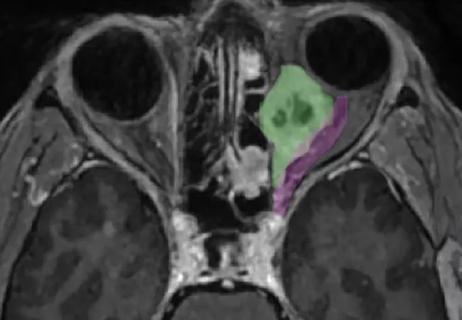Oral medication may have potential to preserve vision and shrink tumors prior to surgery or radiation

Uveal melanoma is a rare cancer with a high risk of recurrence, sometimes metastasizing years or even decades after the initial occurrence. Affecting roughly six people per million, the disease has traditionally been treated with radiation or enucleation, neither of which protects against recurrence. Both options place patients at high risk of vision loss. Researchers at Cleveland Clinic are among a team investigating an oral medication designed to reduce tumor size and preserve eyesight prior to surgery or radiation.
Advertisement
Cleveland Clinic is a non-profit academic medical center. Advertising on our site helps support our mission. We do not endorse non-Cleveland Clinic products or services. Policy
Small- to medium-sized tumors are treated with radiation or plaque brachytherapy while enucleation is usually the treatment option for tumors larger than 10mm in thickness and/or 16mm in basal diameter. This approach has many shortcomings. Radiation of the eye exposes patients to the risk of radiation retinopathy/optic neuropathy, cataracts and/or damage to the surrounding structures.
Uveal melanoma is biologically different from cutaneous melanoma. Unlike cutaneous melanoma, which spreads by lymphatics, uveal melanoma moves through the bloodstream, often into the liver.
Darovasertib is the first targeted oral therapy being studied in the frontline neoadjuvant setting. The goal of this trial is to study whether prescribing darovasertib can shrink tumors prior to radiation or surgery to reduce the risk of these interventions.
“If we can convert a large melanoma to a medium-sized one, there is the potential to save the patient’s eye,” explains Arun Singh, MD, Director of the Department of Ophthalmic Oncology at Cleveland Clinic Cancer Institute. “Secondarily, when you reduce a tumor both in size and base, this can reduce radiation exposure, so the patient has less toxicity from radiation and potential for preservation of vision.”
Another factor is that the disease causes microscopic melanoma cells to circulate in a patient’s bloodstream, where they can spread to the liver or lungs. The researchers are seeking to understand whether darovasertib can target those cells as well reduce the chance of metastasis.
Advertisement
“There is a great deal of interest across solid tumor oncology in neoadjuvant therapy,” says Lucy Kennedy, MD, a Cleveland Clinic Cancer Institute medical oncologist and investigator of the study. “This approach has really taken off across multiple tumor types, such as cutaneous melanoma, breast cancer and lung cancer.”
Finding medications that work in metastatic uveal melanoma has been very challenging. The majority of uveal melanomas have mutations in GNAQ or GNA11. Darovasertib blocks PKC signaling in mutated GNA11 or GNAQ cell pathways. In this phase 2, multicenter trial, each patient will receive neoadjuvant treatment of 300 mg of darovasertib for 28 days for up to six cycles, followed by primary treatment (radiation or surgery). If benefit is observed with neoadjuvant therapy, the patient will be offered six cycles of adjuvant treatment.
Researchers are looking to better understand:
• The tolerability and safety of the medication
• Efficacy rates in tumor reduction
• Impacts on visual acuity, local disease recurrence, metastatic disease and overall survival
The primary endpoint of the study will be eye preservation.
In small studies, darovasertib has shown promising activity for the metastatic disease. A study in Australia resulted in 30-50% tumor reduction size over three to six months of this targeted therapy.
A recent update from the phase 2 study found that of the 49 patients evaluated thus far, roughly half had achieved >30% shrinkage in tumor diameter, while ~61% were able to avoid enucleation in favor of plaque brachytherapy. Side effects noted to date include rash, diarrhea, low blood pressure, nausea and/or fatigue.
Advertisement
Beyond the study, Drs. Singh and Kennedy hope to raise awareness about this cancer and how to diagnose it earlier.
Although some patients may present with blurred vision, retinal detachment or hemorrhage, 10-15% of uveal melanoma cases are incidental findings, where the patient had no symptoms. “People should get regular eye exams, including dilated fundus exams, every year,” says Dr. Singh.
“It’s so important to have community awareness not only about this aggressive cancer but that there are options being studied to hopefully improve outcomes for patients,” says Dr. Kennedy.
Advertisement
Advertisement

Registry data highlight visual gains in patients with legal blindness

Study is first to show reduction in autoimmune disease with the common diabetes and obesity drugs

It’s the first step toward reliable screening with your smartphone

Fixational eye movement is similar in left and right eyes of people with normal vision

A new online calculator can determine probability of melanoma

Therapies include steroid implants, immunomodulation and biologics

Only 33% of patients have long-term improvement after treatment

Novel collaborative approach helps patient avoid orbital exenteration